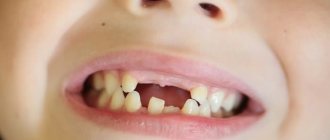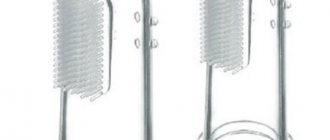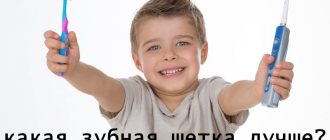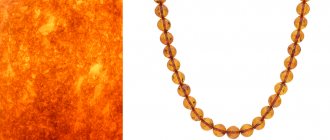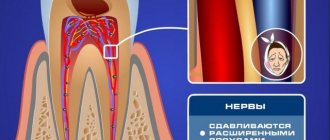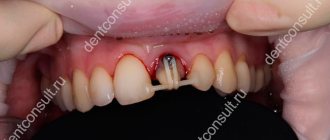What is an orthodontic pacifier?
The main feature of this nipple is its shape - part of it is beveled and flattened, which corresponds to a more natural position in the child’s mouth. Why did they do this? According to these parameters, it corresponds to the anatomical shape of the mother's breast when feeding the baby. This is how you can achieve the most correct grip with your mouth, as well as the desired formation of your bite.
What is an orthodontic pacifier used for? Like any other pacifier, it is given to the child to calm him down, stop crying, and whims. But due to its shape, it also additionally stimulates the development of the jaw apparatus, strengthens joints and has a positive effect on the position of future teeth.
When to use a pacifier
You need to give your child a pacifier if he is in a stressful situation - a car ride, a doctor's examination, a long walk or getting dressed/undressed.
The pacifier helps the baby relax and calm down, and can be used before bed.
Instead of rocking your baby in your arms or on a fitball, or lying down in an uncomfortable position for breastfeeding, cover your baby with a blanket, give him a pacifier and pat him on the back - sleep will not take long to come.
At two months of age, when it’s time for colic, a pacifier will also come in handy. When sucking it, saliva is produced, which has a beneficial effect on the digestive system and intestinal motility, which means that the passage of gases is easier and the tummy stops bothering the baby.
If you notice that your baby or toddler constantly sucks on his fist, then it is better to give him or her a pacifier, it will be much more hygienic, and then it will be easier to remove the pacifier from the mouth than a fist or finger.
How to make a choice?
When entering a store that sells baby products, it’s easy for new parents to get confused. After all, the offer of even just pacifiers represents a huge number of models, colors, sizes, materials, etc. Let’s try to determine what you need to pay attention to when choosing a baby pacifier for the first time:
- The material from which its main part is made is the one that the baby will directly suck on. Recently, manufacturers have settled on two options - latex and silicone. The first is more natural, but has a slight aftertaste that some children do not like. The second one has hypoallergenic characteristics, is colorless and odorless, elastic and lasts longer.
- The shape of the nipple can also be different - round, beveled, flat, etc. We point out that the orthodontic one is the most acceptable, since it completely follows the shape of the breast and best matches the natural position of the child’s tongue and jaws.
- The size of the pacifier is important - you need to pay attention to the age of the baby for whom it is intended, indicated on the label. So, they are usually divided for children up to six months, up to one year and up to two or three years. It is obvious that even if you buy a pacifier of the correct shape, but a larger or smaller size, you will harm the development of the bite.
- Color - here the choice remains only with the parents, since for the baby it will not matter yet. The only thing doctors pay attention to is the wish that it be light, neutral tones. After all, a bright object in the child’s visibility range can distract his attention.
- The price of such products fluctuates approximately in the same ranges and differs only depending on the brand, brand, and popularity of the manufacturer.
There are also nipples for bottles of different shapes, including orthodontic ones. If your baby will be fed formula, then it makes sense to choose it according to the specified parameters. This is the only way to be sure that many dental and speech therapy problems will be avoided in the future.
Separately, it is worth pointing out the duration of use of pacifiers made of different materials. Silicone ones are resistant to temperature changes and last much longer. Although over time they may begin to crack and lose elasticity. Latex ones are more fragile, a child can easily bite through them. In addition, such products often begin to stick together and need to be replaced with new ones.
Why doesn't a child take a pacifier?
There are several reasons for giving up a pacifier. They are simple, quite understandable, and easy to fix.
- Wrong size . As already mentioned, each pacifier is marked with the age for which it is designed. Don't neglect this information. Perhaps the pacifier is too big and is simply falling out of the mouth.
- "Tasteless" material . Some babies prefer soft, warm latex nipples, while others prefer elastic, hard silicone ones. Try both options, then you will understand which is preferable for your child.
- Inconvenient shape . This is where some parents have to collect a whole collection of different forms before finding the one they need.
Popular models
In the store you can find the following famous brands:
- Avent (Avent) - silicone products are odorless and tasteless. Specially shaped wings reduce pressure on the child’s gums and are considered a very convenient option. Manufacturers have thought through ensuring daily hygiene by creating a separate cap for each product. They can also be washed in the dishwasher or sterilized in special devices.
- Bibi (Bibi) - there are varieties of latex and silicone models. Clever holes on the wings of the base are designed for better air circulation, which prevents irritation of the skin around the mouth. The quality of the products is such that they do not deteriorate when repeatedly boiled. What parents will especially like is the opportunity to choose interesting and original colors with inscriptions or drawings.
- NUK (Nuk) - the nipple is made from a particularly soft material, and its shape has a good recess, which provides space for the tongue. Sizes are designed for children from toddlers to three years old. Made of latex in such color options as gold, red and blue.
- Dr.Brown (Doctor Brown) - silicone models without taste or smell. The manufacturer offers to purchase a set of two products at once. The comfortable shape and pleasant material help the child quickly get used to the device and happily accept it. The sizes are larger for newborn babies.
- Tommee tippee (Tommy tippee) - silicone models with an emphasis on breathable wings at the base. It is thanks to them that it is easy for the child to hold the pacifier in his mouth and at the same time the skin does not become irritated from increased salivation. Parents will also like the original design and colors.
- Canpol (Kenpol) - the manufacturer offers the widest range of nipples made of latex and silicone. At the same time, various shapes, colors, sizes will help you choose the most suitable one for your baby.
Breaking the habit of bad sucking
It is quite possible to wean a child from sucking a pacifier at 2 years old. This requires friendly attention and help from parents. But it would be wrong to simply take away the baby’s pacifier or prohibit him from sucking his finger. At first, he will need a psychological replacement for the missing items. And until recently, such a replacement existed only for children from 3 years old - in the form of a vestibular plate made of elastic plastic. For younger children, there was no alternative to a pacifier, but the process of self-regulation is most likely at 2-3 years of age; after 2 years, this possibility is significantly reduced.
Therefore, a special elastic pacifier substitute “Stoppi” was developed, which is made from medical hypoallergenic silicone and has special bridges in the side sections for biting them with chewing teeth. Thanks to them, the plate is conveniently placed in the mouth, successfully replacing the baby’s pacifier and preventing deformation of the upper dentition. If the child already has an open bite, it will close naturally, since when using the plate, nothing prevents the child’s front teeth from closing.
Soft bridges for biting.
There are no foreign objects between the incisors.
The shield is located in front of the incisors.
How to properly give an orthodontic pacifier?
In order to preserve all the thoughtful nuances of the chosen model and provide the child with maximum comfort when using it, you need to adhere to certain recommendations:
- Give the nipple with the beveled edge down, which will allow the tongue to move more. Make sure your baby doesn't turn it over in his mouth.
- Be sure to process, wash and sterilize the product every day.
- Before giving a pacifier to a child, you need to carefully inspect it for cracks or other defects.
- It is advisable to replace silicone models with new ones every month, despite the fact that it has not deteriorated externally. But latex ones can be thrown away once every two months.
- Doctors emphasize that even a child should be weaned off an orthodontic pacifier at the age of one.
- Try to use this “helper” only when necessary, without abusing it. When the child falls asleep, you need to carefully remove the pacifier, because this is not a night toy.
Video: how to choose a pacifier?
If your baby spits out the pacifier
Most often, newborns spit out the pacifier if they have an incorrect bite or a high palate; in this case, you need to contact your pediatrician and dentist so that specialists can help you choose the right option for your child.
The second, most common case, when the child is breastfed, all substitutes for the mother's breast lose greatly. Don't despair, choose the softest nipple, warm it up in hot water for the first time, then you won't notice much of a difference, and you'll soon achieve results.
Dr. Komarovsky's opinion: Evgeniy Olegovich believes that the pacifier was invented in order to solve some parental problems, for example, not training your hearing by listening to the loud howls of a two-month-old baby, who is forced to suck on rattles instead of a comfortable pacifier.
But he reasonably adds that if the pacifier itself turns into a problem, then it should be eliminated immediately. Each child has the right to decide for himself whether he needs this item or not.
Breastfeeding experts unanimously say that a baby does not need a pacifier at all. She just gets in the way. If you definitely want to introduce your baby to a rubber breast substitute, then you should do this only after lactation is completely established. To support this, experts cite the following arguments:
- The baby, although he has a strong sucking reflex, is not able to quickly change technique; the breast and pacifier require different grips. If a child tries the pacifier, he may completely give up breastfeeding, as this is a more labor-intensive process.
- Rare breastfeeding at an early stage can cause lactostasis; in severe forms, it is dangerous due to the formation of inflammation and mastitis.
- If a baby rarely takes the breast, milk production decreases, which can lead to malnutrition, weight loss and even dehydration, since foremilk is 80% water.
Which is less harmful: a pacifier or a finger?
Doctors are unanimous on this issue: it is better to let the child suck a pacifier than his own finger. This is especially true for the period when baby teeth have not yet appeared. There are several reasons for this:
- The habit of thumb sucking is much stronger, because it is always there, you don’t have to ask or look for it like a pacifier.
- An infant who has a particularly strong need to satisfy the sucking reflex may seriously deform his finger.
- A pacifier made of high-quality materials and suitable for the baby’s age has much less negative impact on the jaws.
- The pacifier is easier to keep clean, it is disinfected, and you can be sure that the infection will not get into the child’s oral cavity in this way.
It is better to wean your baby off the habit of thumb sucking as early as possible, distracting him in every possible way with a pacifier or special latex teething toys.
At what age does a child develop a bite?
The bite is formed in children from the moment they are born.
And it goes through several stages:
- 0-6 months. During this period, the correct development of the jaws is important, as they prepare for the appearance of the first teeth.
- 6 months – 3 years. Formation of temporary occlusion.
- 3-6 years. Formed temporary occlusion, preparing the jaws for the appearance of permanent teeth.
- 6-12 years old. Formation of a mixed dentition due to the replacement of baby teeth with permanent ones.
- 12-15 years old. Formation of a permanent bite.
Speaking about whether the pacifier affects the child’s bite, we must not forget that the process of jaw formation is long and it begins from the moment the child is born, and not with the appearance of the first teeth. Therefore, it is important to monitor their condition until adolescence.
What is the difference between a pacifier and a pacifier?
A pacifier and a pacifier are visually similar, but they are used in different situations. The nipple has one or more holes through which the baby receives nutrition. It is put on a bottle from which the baby is given formula, water, tea or fruit juices. If you use a pacifier without a bottle, this can lead to colic in your baby.
A pacifier is another product that is used to calm a child. It is designed hermetically, so the baby does not gasp for air while sucking.
Rating of the best pacifiers for newborns
| Nomination | place | Name of product | price |
| The best classic pacifiers | 1 | Philips Avent Classic SCF195/03 0-6 months. | 550 ₽ |
| 2 | Dr.Brown's pacifier from 0 to 6 months | 232 ₽ | |
| 3 | Philips Avent Night SCF176/22, 6-18 months. | 590 ₽ | |
| The best anatomical pacifiers from 0 to 6 months | 1 | Chicco Physio Comfort “Squirrel” silicone from 0 to 6 months | 275 ₽ |
| 2 | Philips Avent FreeFlow SCF172/13, 0-6 months. | 316 ₽ | |
| 3 | Dr.Brown's from 0 to 6 months | 299 ₽ | |
| 4 | Philips Avent Mini SCF151/00 for babies, 0-2 months. | 320 ₽ | |
| The best orthodontic pacifiers | 1 | Philips Avent FreeFlow SCF172/15 | 316 ₽ |
| 2 | Canpol Babies Machines from 6 to 18 | 228 ₽ | |
| 3 | Philips Avent Ultra Soft from 6 to 18 months | 535 ₽ | |
| 4 | Dr.Brown's PreVent sleep pacifier from 0 to 6 months | 500 ₽ |
Should you accustom your child to a pacifier: pros and cons
The sucking reflex is the most important skill that a child needs for survival, as it provides nutrition, and for establishing a strong psycho-emotional connection with the mother.
If the baby is breastfed and sucks on his mother’s breast at the first request, then the sucking instinct is fully satisfied, so he does not need a pacifier. In addition, many natural scientists themselves are beginning to abandon this device.
Another thing is a baby on artificial feeding or a baby who receives mother's milk by the hour. These babies need a pacifier because their need to suckle at the breast is partially or not met at all.
Some physiological experiments have shown that when weaned from the mother's breast, babies' heart rates begin to increase. But if at this moment you offer them a pacifier, the heart contractions will gradually return to normal. This happens because a pacifier relieves stress and suppresses the expression of negative emotions.
Thus, experts, answering the question of why it is necessary to use a pacifier, give the main argument - the child calms down and quickly falls asleep due to the complete satisfaction of the sucking reflex.
Pros of using a pacifier
Stimulating vital unconditional reflexive behavior is not the only benefit of using pacifiers. According to the beliefs of some experts, a pacifier can perform several useful functions, among which are the following:
- assistance in preventing colds during the cold season;
- regulation of feeding schedule;
- prevention of thumb sucking;
- falling asleep faster and prolonging restful sleep;
- reduction of pain during teething;
- prevention of sudden infant death syndrome due to the fact that the tongue does not sink;
- reduction of negative feelings in painful conditions;
- stimulation of the release of gases from the gastrointestinal tract, which helps relieve the child from colic;
- improvement of bite when choosing a special orthodontic attachment.
Many parents note that the use of this hygienic device allows them not to worry about the fact that a baby who has learned to walk will pick up various dirty objects in the sandbox or just on the street and put them in his mouth.
Disadvantages of using a pacifier
It is possible to accustom a baby to a pacifier, but many experts argue against this process, since the benefits of sucking can be outweighed by negative consequences.
Experts attribute the following aspects to the negative aspects of using pacifiers:
- incorrect selection of pacifiers can lead to malocclusion;
- sucking on a hygienic device can provoke the child to refuse the breast, which will ultimately result in a transition to mixed or artificial feeding;
- a child who is accustomed to a pacifier is more likely to be at risk of contracting infectious diseases of the mouth;
- formation of the habit of sucking a pacifier, as a result of which parents have to wean themselves off the pacifier;
- grasping a pacifier with your lips is different from sucking a breast, as a result of which the mother may feel discomfort when feeding the baby;
- inhibits the child’s development, the child’s interest in the world around him decreases.
The question of whether a child needs to be accustomed to a pacifier is decided solely by the parents, based on the recommendations of the pediatrician. A thoughtful and balanced decision will allow you to avoid the negative consequences described above.
Doctor Komarovsky's opinion
TV doctor E.O. Komarovsky, widely known and respected by mothers, is convinced that the positive and negative properties of pacifiers are overly exaggerated. The main principle of their use, according to the pediatrician, is mandatory compliance with hygienic requirements.
However, Komarovsky does not recommend accustoming a child to a pacifier if a woman has certain problems with the volume of milk secretion. The baby, distracted by the pacifier, will have less intense influence on the mother's nipples, which can lead to suppression of lactation.
But another situation should be taken into account - when the child is literally hanging on his mother’s breast, trying to realize his sucking reflex. In this case, a pacifier will allow the mother to free up some time and ensure peace in the house.
General harm from pacifiers
When parents think about whether the pacifier spoils the child’s bite, it turns out that there are some other negative aspects that this item can bring. Sucking on a pacifier for a long time can cause:
- Refusal to suck milk from the breast;
- Incorrect latching of the nipple during sucking, which can lead to breastfeeding pain for the mother.
- Speech delay, incorrect pronunciation of sounds and words.
- Allergic reaction.
- Delayed mental development of the child.
- Oral diseases.
- Mechanical damage in the mouth and chin area.
However, most pediatricians are of the opinion that using a pacifier for up to six months should not cause serious harm to the baby. After 6 months, the use of a pacifier is undesirable, and after a year it is necessary to reduce this habit in the child.
Optimal age for training
Another common question that mothers ask themselves and experts concerns the age at which a child can be given a pacifier. The answer will again depend on the type of feeding.
So, if a child is fed formula from the first days of life, then he will have to use a pacifier literally from birth. The point here is that a bottle-fed baby takes food from a bottle much faster than a naturally fed baby. As a result, the sucking reflex cannot be fully realized.
For a newborn who feeds on mother's milk, such a problem is not typical. Therefore, a woman should not rush into inserting a pacifier. If there is a need for it, then you can give a pacifier to a baby at 1 month of age, but not earlier than 3 - 4 weeks of age.
A newborn baby must master the method of “extracting” milk from the mother’s breast. This usually happens already in 1 week of life, but excessive haste with a pacifier can interfere with the establishment of lactation, which threatens the baby’s refusal to breastfeed.
A special case is a premature baby whose sucking reflex is poorly developed. In this case, many pediatricians even advise giving the baby a pacifier so that with its help he learns to suck correctly. In such a situation, the device should be selected especially carefully.
Why do babies love pacifiers?
All healthy children have a need to suck the mother's breast - this is how an innate reflex manifests itself. Without it, the newborn would be doomed to death. Sucking movements reduce tension in the spine received after childbirth. In the process, a signal is delivered to the baby’s brain that everything is fine, and he quickly calms down.
By the age of six months, the sucking reflex gradually weakens, and by the age of 3-4 years it usually disappears completely. Most children, long before this age, cease to need both the nipple and the mother's breast.
This is interesting ! Eternally busy parents have existed at all times, so the pacifier was used as a breast surrogate among many peoples. The Egyptians used smooth pebbles for this purpose, the Chinese made leather teats from the udder of a cow, and in Russia they chewed bread, placed it in a bag and gave it to the baby.
How to treat your pacifier before first use
When purchasing a pacifier at a pharmacy or store, you should not immediately give it to your baby . The accessory must be prepared for sucking. After removing from the packaging, pacifiers should be washed in a warm soapy solution, rinsing under running water.
The second stage is sterilization, designed to destroy bacteria and contaminants that were not washed off with water. There are several heat treatment methods:
- it is allowed to boil the pacifier in an enamel or aluminum pan with water for at least 2-3 minutes;
- it is convenient to process the nipple in special sterilizers for bottles, placing it in a container intended for this purpose and disinfecting it for the time specified by the device;
- You can boil baby pacifiers in a container of cold water in a microwave oven at maximum power, or in a double boiler or multicooker by setting the appropriate mode. Treatment duration is 6-8 minutes;
- Another way is to treat the pacifier in cold water with the addition of antiseptic tablets.
Attention! You should boil the pacifier after purchasing it and every time it falls on the floor.


